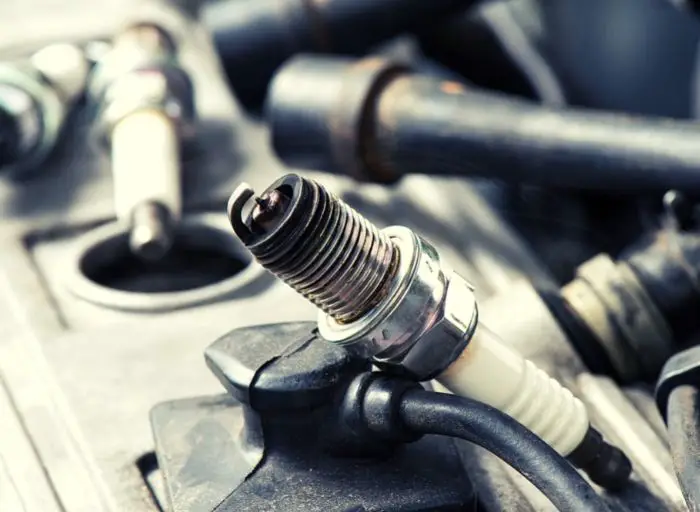
Oil in spark plug well indicates a significant problem that should be investigated and addressed soon. It’s mostly caused by a faulty gasket or O-ring, although it can also be caused by a worn piston or valve guides.
Table of Contents
How Does This System Function?
The spark plugs and the engine lubrication system are also involved in this problem. A spark plug’s primary duty is to ignite the fuel/air combination in the combustion chamber. Electrical energy is carried through the spark plug, which leaps the gap and ignites the gasoline and air mixture with a spark. Spark plugs also remove heat from the combustion chamber by acting as a heat exchanger, transferring thermal energy from the combustion chamber to the cooling system.
Engine oil is used to maintain the engine’s working parts. Heat is produced by the constant movement of engine parts and wear and tear. Engine oil aids in reducing friction and the dissipation of heat produced by the engine.
Engine oil is kept in the oil pan. A typical oil pan has a capacity of 6 quarts. The oil pump draws oil from the oil pan through the pickup tube when the engine begins. Next, the oil passes through an oil filter, which filters out dirt and debris before being supplied to various engine sections via spurt holes. It eventually returns to the oil pan to begin the process again.
Oil in Spark Plug Well Causes
There are several reasons for oil in the spark plug well and some common signs.
1. A deteriorated valve cover gasket
If you look at your car’s engine, you’ll discover a metal cover called the “valve cover.” This seal is intended to keep leaks from the vehicle’s engine. Nonetheless, gaskets exist between the valve cover and the engine, and they tend to deteriorate over time.
The engine’s high temperature makes such failure more pronounced, and the valve cover gasket becomes brittle. As a result, you may notice minor leaks quickly, allowing oil to enter the spark plug well.
2. O-Ring seal failure
Oil can flow past these seals and into the spark plug well if the O-Ring seals at the bottom of the spark plug wells start to fail. This problem should be resolved as quickly as possible, and the spark plugs should be replaced.
3. Piston failure
Aside from allowing engine oil to flow into the cylinder and soaking the spark plug, a damaged piston can also lead the oil in the spark plug well to become contaminated. In addition, the piston may shatter due to the extreme heat.
Engine misfire, rattling noises, and excessive oil combustion can all be symptoms of a damaged piston. You should not ignore such a problem and address it as soon as possible to improve the performance of your engine.
4. Piston compression rings that have failed
Piston rings sit above and below the piston, preventing oil from entering the car’s combustion chambers. These rings also help drain excess oil that has reached the cylinder walls.
Oil can rarely be prevented from going towards your spark plugs by worn-out piston compression rings. The engine oil scent would be noticeable throughout the cabin in this instance. Every day, you would notice the car’s blue exhaust.
5. Damaged valve guides
Valve guides keep the valves in place when the engine is running, which helps to regulate air intake. Valve guides can become highly worn over time and need to be replaced. A standard indicator of failed valve guides is blue smoke and ash in the spark plug wells. Valve guides that have worn out might cause more significant engine problems. Therefore, they should be replaced as soon as possible.
How to Fix Oil in Spark Plug Well
It’s vital to remember that replacing the spark plug wells totally isn’t always necessary. Simply changing portions of the valve, particularly the cap, is enough to cure an oil-filled spark plug.
If the gasket around the spark plug isn’t properly sealed, the oil will leak into that area, pool, and eventually cause difficulties for the engine, as described above. Although this is the most typical cause of the problem, it can also be caused by a faulty piston or worn valve guides, so your mechanic should also look at those.
You or a mechanic should inspect all related parts like the valve cover gaskets or O-ring seals to rule out any potential additional damage beyond the surface-level valve seal.
Oil in Spark Plug Well Symptoms
A few indications indicate that oil is present in the car’s spark plug well. With these frequent indicators, you may quickly identify a problem and resolve it before the vehicle gets further issues. When trying to figure out how to remove oil from the spark plug well, these signals come in handy. The following are some of the most prevalent signs of oil in spark plug wells:
1. The smell of gas coming out of the tailpipe
Have you ever been puzzled about why you can smell gas coming from your car’s exhaust pipe? This could suggest that there is oil in the spark plug well of your Toyota Camry. However, this applies to many other vehicles, and the odor can even reach the car cabinet in certain situations.
2. Blue smoke from the exhaust
Blue smoke from the exhaust pipe may soon appear, suggesting that oil is being consumed somewhere in the engine. If there is oil in the spark plug well, similar symptoms occur. Oil on the spark plug reduces the engine’s efficiency and influences how it burns fuel. The fuel supply increases as the ECU attempts to adjust the fuel ratio. The exhaust valve would pass extra unburned fuel into the combustion chamber.
3. Engine performance decrease
Spark generation is reduced as the oil in the spark plug well makes contact with the plug. Keep in mind that this spark controls the car’s ignition. The spark plug tip being contaminated with oil would be devastating. In other words, the fuel/air mixture would have a lower likelihood of igniting in the vehicle’s combustion chamber. If there is no proper combustion, the engine will be inadequate pressure to perform correctly.
4. Misfiring engine
Because of incomplete fuel/air mixture combustion, engine misfiring can happen in any engine’s cylinders. In addition, the spark plug is less likely to create enough spark to finish the ignition of the gas/air mixture if there is oil in the well. As a result, you will notice misfiring in your vehicle’s engine.
5. Increased fuel consumption
An increase in fuel usage suggests that oil has fouled the spark plug. In other words, if you see an increase in fuel use, check to see if the spark plug has any oil on it. This sign will teach you how to empty the spark plug well of oil.
6. Backfiring of the engine
Backfiring happens when the fuel/air mixture burns outside the engine cylinder’s combustion chamber. This symptom develops when there is oil in the spark plug well. It’s produced by faulty fuel particle combustion, which leads them to migrate into the exhaust.
Conclusion
For gasoline-powered automobiles, spark plugs are required. If the spark plug is damaged, the engine will suffer, and you may notice that the car starts but does not stay running.
There would be less spark production for ignition if there were oil in the spark plug well. Therefore, cleaning the spark plug hole, replacing the spark plugs, and replacing the O-ring seals may be critical. Reading this article, you may learn more about the origins, symptoms, and solutions for oil on the spark plug.
Hi there! I’m Naomi O’Colman. I’ve got years of experience working at an auto repair shop here in Texas under my belt. On top of that, ever since I was a kid I’ve been passionate about the auto industry. Since I’ve joined the team at automotivegearz.com I’ve been enthusiastically sharing my passion and insights with my readers. I’m dedicated to delivering high quality content and helping you stay up to date with the latest automotive trends and products out there!







